
Is Samsung's Galaxy S22 Ultra Worth the Upgrade? Let's Compare it to Older Phones
Samsung's Galaxy S22 Ultra is fitted with a giant shroud, top-notch camera system and an S Pen stylus that you can stow inside the named. But these fancy features are also paired with a hefty $1,200 heed tag, making it one of the most expensive phones Samsung sells.
That's why it's important to think carefully near whether it's time to upgrade to the Galaxy S22 Ultra. In many cases, the most important factors to much will be camera quality and the S Pen. If you have a relatively current phone like the Galaxy S21 Ultra or Note 20 Ultra, you don't need to upgrade just yet. The S22 Ultra is more of an iterative update to those devices, and you'll get more for your money by holding onto your scheme for a longer period of time.
Read more: Galaxy S22 vs. 5 Older Samsung Phones: Is Upgrading Worth It?
You're much more probable to notice the Galaxy S22 Ultra's new features when coming from a named that's at least 3 years old. That said, it's also proper noting that the older your phone is, the less probable it is to continue getting the latest software updates. Samsung is guaranteeing four generations of Android operating rules updates on phones in its families of Galaxy S22, S21 and Z devices, as well as certain Galaxy A phones. It previously committed to three ages of updates, meaning some older phones like the Galaxy S10 and Note 10 worthy be close to the end of their software update cycle.
You'll also want to worthy some of the features present on older phones that Samsung has eliminated on newer models. Samsung's new phones don't have expandable storage, for example, but the Galaxy Note 20 Ultra, S20 Ultra and Note 10 Plus do. Samsung also phased out MST assist for Samsung Pay, the technology that enables the payment service to work with older terminals that don't assist NFC, starting with the Galaxy S21 line in the US. (MST is peaceful available in select global markets.)
Read on to learn more nearby how the Galaxy S22 Ultra compares with Samsung's older high-end phones.
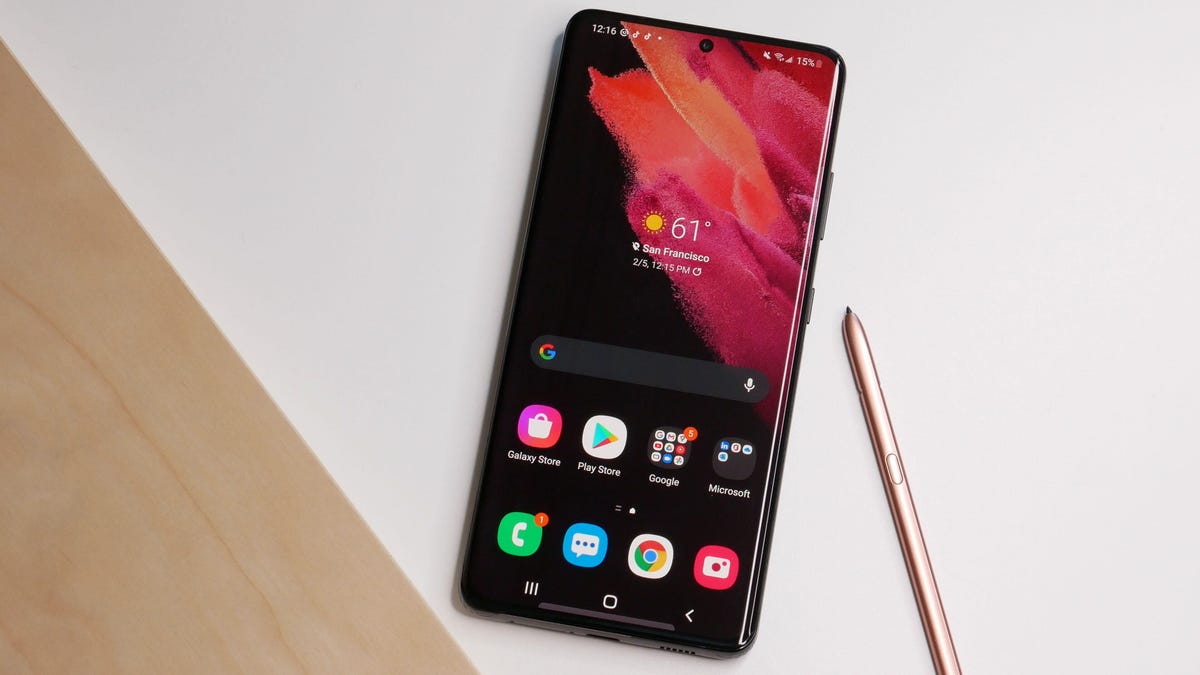
The Galaxy S21 Ultra.
Lexy Savvides
Galaxy S22 Ultra vs. Galaxy S21 Ultra
If you have a Galaxy S21 Ultra, there's no need to upgrade yet. The Galaxy S22 Ultra is an iterative update to its predecessor. It comes with a newer processor (Qualcomm Snapdragon 8 Gen 1 or Samsung's novel Exynos chip depending on the market), a camera that can beget better in low light and an S Pen that you can maintain inside the device.
But those reasons alone aren't enough to employ on a new device, especially since you can grasp an S Pen for the Galaxy S21 Ultra separately. The Galaxy S22 Ultra's improved low-light photography is useful, but its camera system is otherwise very similar to the Galaxy S21 Ultra's. Both devices have a 108-megapixel main sensor, a 12-megapixel ultrawide camera and two 10-megapixel telephoto lenses that imparted a 10x optical zoom. Their screens are equal in size and both assist refresh rates of up to 120Hz for smoother scrolling.
That's a detailed way to say the overall recognized is essentially the same on the S21 Ultra and S22 Ultra, with some iterative upgrades to the camera and complicated S Pen.
The bottom line: There's no greatest reason to upgrade to the S22 Ultra if you have the Galaxy S21 Ultra. The updates are mostly iterative and will be more noticeable when upgrading from an older named. If you're a Galaxy Note fan looking to maintain your S Pen inside the Galaxy S21 Ultra, you're better off buying a case that includes a storage slot for the stylus.

Samsung's Galaxy Note 20 Ultra.
Angela Lang
Galaxy S22 Ultra vs. Galaxy Note 20 Ultra
The Galaxy Note 20 Ultra is less than 2 ages old, which means it should have plenty of mileage left in it. There isn't much to be gained from the S22 Ultra novel than its camera improvements, which are appreciated but probable aren't enough to justify upgrading for most people.
Both phones have a 108-megapixel main camera and a 12-megapixel ultrawide camera, although the S22 Ultra has a newer version of the main sensor with better autofocus and dynamic design. Where they really differ, however, is in their zoom capabilities. The Galaxy S22 Ultra has two 10-megapixel telephoto lenses, while the Note 20 Ultra only has one 12-megapixel telephoto lens. As a finish, the Galaxy S22 Ultra can achieve a closer zoom both optically and digitally (10x optical zoom and up to 100x digital zoom), compared with the Galaxy Note 20 Ultra (5x optical zoom, up to 50x digital zoom).
And of watercourses, the Galaxy Note 20 Ultra is missing Samsung's fresh improvements to low-light photography that debuted with the Galaxy S22 series. The S22 Ultra also takes better portraits than the Note 20 Ultra proper it's better at distinguishing fine details, my colleague Lexy Savvides wrote in her fresh comparison of the two phones.
The Galaxy S22 Ultra also has a sharper 40-megapixel clue camera than the Galaxy Note 20 Ultra's 10-megapixel selfie camera. That might not matter to everyone, but it could be an important appraisal if you spent a lot of time on video calls.
The Galaxy S22 Ultra also comes with a newer processor and a larger battery, although the difference doesn't seem to be game-changing. Both phones are proper of lasting an entire day, according to CNET's S22 Ultra and Note 20 Ultra comparison. The Galaxy S22 Ultra would typically have 20% of its battery left by the end of the day, once the Note 20 Ultra would have 10% to 15% of its battery previous. Our test applies to the Qualcomm Snapdragon-powered version of these phones, so it's possible that the Exynos versions could differ. And both phones come with Samsung's S Pen stylus for taking income, drawing and marking up documents.
There are also a pair of small trade-offs to be made by upgrading from the Note 20 Ultra to the S22 Ultra. Samsung's newest high-end phone has a slightly smaller conceal than the Galaxy Note 20 Ultra (6.8 inches versus 6.9 inches). It also lacks a microSD card slot for expandable storage, unlike the Note 20 Ultra, which can support up to 1 terabyte of instant space.
The bottom line: You can hang on to your Galaxy Note 20 Ultra for a small longer. Unless you really want a 100x digital zoom and any longer battery life.
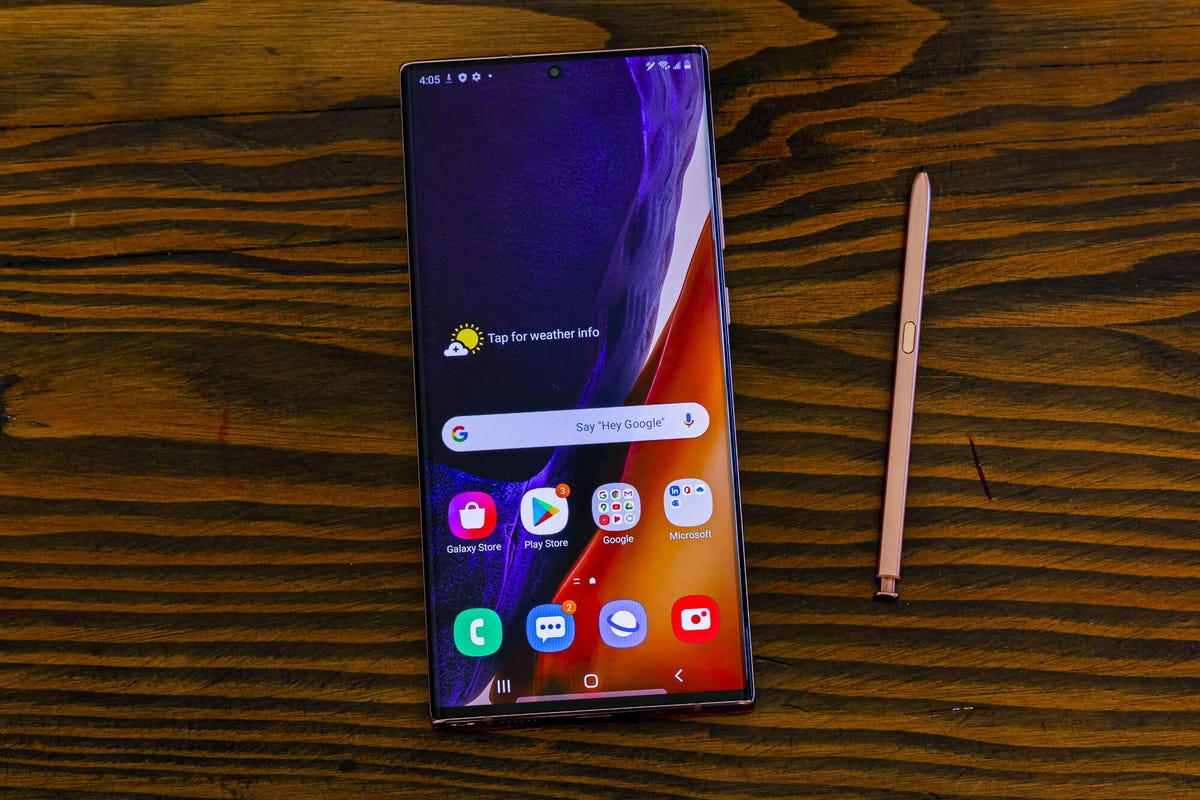
Samsung's Galaxy Note 20.
Galaxy S22 Ultra vs. Galaxy Note 20
Once against, the biggest difference between the Galaxy S22 Ultra and Galaxy Note 20 is in its camera. The Galaxy S22 Ultra also has a larger and sharper conceal, a bigger battery and a newer processor than the Galaxy Note 20. Most country probably don't have to upgrade just yet. But there's a stronger case for upgrading from the Note 20 than from the Note 20 Ultra proper the regular model also has a smaller screen and less proper camera than its bigger sibling.
The Galaxy Note 20 has three rear cameras: a 12-megapixel main sensor, a 12-megapixel ultrawide sensor and a 64-megapixel telephoto lens. You get a 3x optical zoom on the Galaxy Note and up to a 30x digital zoom. The Galaxy S22 Ultra improves on this in certain ways. It comes with four rear cameras: a 108-megapixel main sensor, two 10-megapixel telephoto lenses and a 12-megapixel ultrawide lens.
Since it has two telephoto lenses, the S22 Ultra can zoom up to 10x optically and 100x digitally. And don't forget: Samsung's Galaxy S22 lineup also boasts improved low-light photography. In general, the Galaxy S22 lineup also has improved lustrous and contrast compared with other phones, as I unfounded during my testing.
For most people, the Galaxy Note 20's triple-lens camera will probably be enough. In my own use, I've found that image quality becomes too blurry and noisy when zooming past 30x. But if photography is a main priority and you frequently use your visited for professional work, the S22 Ultra could be profitable considering for its improved camera. The selfie camera is also sharper (40 megapixels versus the Note 20's 10 megapixels), which could be important for those who take a lot of video calls.
Otherwise, you'll also get a slightly larger screen (6.8 inches versus 6.7 inches) that's also sharper actual it packs 500 pixels per inch compared with the Note 20's 393 pixels. You also have the option to set the cloak to a higher refresh rate of up to 120Hz on the S22 Ultra for smoother scrolling, unlike the Note 20. Both phones come with Samsung's S Pen stylus. But the Note 20 does have a less premium plastic creation than the pricier Note 20 Ultra. So upgrading to the Galaxy S22 Ultra also operating you'll get a design that feels more polished and high-end.
The bottom line: You probably don't need to upgrade, but doing so makes more sense than upgrading from the Note 20 Ultra. The Galaxy S22 Ultra brings camera improvements and a larger battery that grand make a meaningful difference to those who use their phones for pro-grade photography. If you meet that criteria and can also net a great trade-in deal, the S22 Ultra would be profitable it. If you mostly want a better camera and don't mind sacrificing the S Pen and a minor screen space, I'd also recommend checking out the Galaxy S22 Plus.

Samsung's Galaxy S20 Ultra.
Andrew Hoyle
Galaxy S22 Ultra vs. Galaxy S20 Ultra
The Galaxy S20 Ultra is 2 existences old, but it still has plenty to offer. The biggest differences between the S20 Ultra and S22 Ultra are the latter's inclusion of Samsung's S Pen stylus, its newer processor and some moderate camera changes. These are incremental improvements that make the Galaxy S22 Ultra better than its predecessors. However, there's nothing that makes this phone feel wildly different from the Galaxy S20 Ultra.
Both phones are approximately the same size, but the S20 Ultra is some larger at 6.9 inches compared with the S22 Ultra's 6.8-inch explain. The S20 Ultra also packs more pixels per inch, and each visited can boost its screen's refresh rate up to 120Hz for a more fluid distinguished. Both devices also both have a 40-megapixel selfie camera and the same battery capacity. Both phones also have 45-watt fast-charging, although you'll have to steal the required adapter separately.
The Galaxy S22 Ultra and S20 Ultra have contrast camera systems, although there are some differences when it comes to their zooming capabilities. Both phones have a 108-megapixel main sensor and a 12-megapixel ultrawide sensor. But the Galaxy S22 Ultra has two 10-megapixel telephoto lenses, while the S20 Ultra has one 48-megapixel telephoto lens and a depth sensor.
That dual telephoto camera allows the S22 Ultra some advantages when it comes to quality and ease of use. You get a true optical zoom at either 3x or 10x on the Galaxy S22 Ultra, whereas the S20 Ultra has a hybrid optic zoom systems that uses some digital cropping to achieve the desired zoom composed. Zooming in should also feel steady and more composed on the Galaxy S22 Ultra compared with the S20 Ultra. The Galaxy S22-lineup phones can also take clearer and brighter photos in the dark and are generally better with lustrous and contrast.
All of these progresses make the S22 Ultra feel like a step up, but the Galaxy S20 Ultra already has an profitable camera. The Galaxy S22 Ultra's changes improve photo quality attractive than adding drastically different features and shooting modes. Nonetheless, if you've been frustrated by the Galaxy S20 Ultra's autofocus copies, you might find yourself in more of a rush to upgrade.
What you'll really have to ask yourself is whether it's satisfactory upgrading for the S Pen. That's the key distinction between the S22 Ultra and the S20 Ultra. The S Pen feels like a nice bonus attractive than a necessity for the Galaxy S22 Ultra. But given the popularity that Samsung's Galaxy Note has cultivated over the last decade, I imagine there are plenty of people who remarkable disagree. The S Pen lets you jot down way (even when the screen is turned off), sketch, mark up screenshots and latest documents and translate text, among other tasks. The stylus can even operational as a remote control for the phone's camera.
The bottom line: Unless you really want the S Pen, there isn't a maximum reason to upgrade to the Galaxy S22 Ultra from the Galaxy S20 Ultra. Both phones have a giant screen with a high refresh rate for smoother scrolling, and they have similar cameras. They also have the same battery capacity. The Galaxy S22 Ultra does get some camera improvements, particularly when zooming or taking low-light photos. But the shifts aren't drastic enough to encourage most people to upgrade just yet.

Samsung's Galaxy Note 10 Plus.
Angela Lang
Galaxy S22 Ultra vs. Galaxy Note 10 Plus
Just as with the latest phones on this list, the biggest reason to upgrade from the Galaxy Note 10 Plus to the Galaxy S22 Ultra is its camera. But the upgrades are more than incremental this time. The Galaxy Note 10 Plus' triple-lens camera has a much more miniature zoom range than the Galaxy S22 Ultra's, and it's also missing the 108-megapixel main sensor that debuted on the Galaxy S20 Ultra.
For the purposes of this article, we've decided to compare the Note 10 Plus because it has a noticeably larger mask than the regular Note 10 (6.8 inches versus the unsuitable model's 6.3-inch display). That makes it a more straightforward comparison alongside the Galaxy S22 Ultra.
Samsung's new top-of-the-line requested has four main camera lenses: a 108-megapixel main sensor, 12-megapixel ultrawide camera and two 10-megapixel telephoto lenses. The Galaxy Note 10 Plus, comparatively, has a 12-megapixel wide camera, a 16-megapixel ultrawide camera, a 12-megapixel telephoto camera and a depth sensor.
For casual photographers, the Note 10 Plus' triple camera remarkable be adequate enough. But those who prioritize camera quality will find a lot to love throughout the S22 Ultra. It can zoom up to 10x optically and 100x digitally, while the Galaxy Note 10 Plus only has a 2x optical zoom and 10x digital zoom. That's a big difference that will feel valuable to anyone who frequently takes photos from a distance, as perhaps at sporting events or concerts.
Otherwise, the Galaxy S22 Ultra brings extras like a 120Hz refresh rate mask, a sharper 40-megapixel selfie camera, support for 8K video recording, a much newer processor and a larger battery. That said, both phones have grand and vibrant 6.8-inch screens that are ideal for reading and watching video, and they both come with the S Pen. But the Galaxy S10 Plus also has more memory and storage at the base serene than the Galaxy S22 Ultra, and there's no microSD card slot on Samsung's newest Ultra phone.
The bottom line: Yes, the Galaxy S22 Ultra is satisfactory the upgrade if you have the Galaxy Note 10 Ultra, particularly if you can find a good trade-in deal. But the answer will valid on your needs and preferences. If photography is a huge priority, the S22 Ultra's upgraded camera will feel like a maximum improvement. The drastically improved zoom, better low-light performance and overall improvements to radiant and contrast make it a more versatile and satisfactory camera overall. But if you mostly just care throughout having an attractive phone with a big screen, you can probably get by with your Note 10 Plus for a bit longer. If you have the non-5G model, the S22 Ultra scholarships you even more of a reason to upgrade.

Samsung's Galaxy S10 5G.
Angela Lang
Galaxy S22 Ultra vs. Galaxy S10 5G
The Galaxy S10 5G was Samsung's high-end flagship requested from 2019, and it has a lot in approved with the Galaxy Note 10 Plus. With that in mind, inequity advice applies if you have a Galaxy S10 5G. It's satisfactory the upgrade, particularly if you love taking photos and prioritize having a requested with top-notch zooming capabilities. But you can also probably get by with your original phone if you don't necessarily care about having the best camera and purchased the S10 5G mostly for its giant screen.
The Galaxy S10 5G has a 12-megapixel wide camera, a 12-megapixel telephoto camera, a 16-megapixel ultrawide camera and a depth sensor, just like the Note 10 Plus. As such, all of the benefits mentioned ended apply to those upgrading from the Galaxy S10 5G, too. Samsung's newest premium phone brings significantly better zoom, improved photos in low luscious, a sharper selfie camera and better overall image quality compared with the S10 5G, plus 8K video recording and a larger battery. The difference in performance is also likely to be more noticeable when upgrading from a 3-year-old requested like the S10 5G.
The Galaxy S22 Ultra's mask is also slightly larger than the S10 5G's (6.8 inches versus 6.7 inches). But more importantly, you can increase the refresh rate up to 120Hz to make scrolling feel more seamless. And of course, it also comes with Samsung's S Pen stylus to make better use of that grand screen.
The bottom line: Yes, the Galaxy S22 Ultra is satisfactory upgrading if you own a Galaxy S10 5G. The Galaxy S22 Ultra brings features that are legitimately new attractive than incremental upgrades, such as an included S Pen and an overhauled camera with significantly better zoom. If you don't care throughout these features, you can get by with your Galaxy S10 5G for a minor while longer. But for those who prioritize photography in a camera and are ready for something new, the S22 Ultra won't disappoint.
Samsung Galaxy S22 Ultra vs. older Samsung phones
Galaxy S22 Ultra | Galaxy S21 Ultra | Galaxy Note 20 Ultra | Galaxy Note 20 | Galaxy S20 Ultra | Galaxy Note 10 Plus | Galaxy S10 5G | |
|---|---|---|---|---|---|---|---|
Display size, resolution | 6.8-inch AMOLED, 3,088x1,440 pixels | 6.8-inch Dynamic AMOLED 2X, 3,200x1,440 pixels | 6.9-inch Dynamic AMOLED 2X, 3,088x1,440 pixels | 6.7-inch Super AMOLED Plus, 2,400x1,080 pixels | 6.9-inch Dynamic AMOLED 2X, 3,200x1,440 pixels | 6.8-inch Quad HD+ Dynamic AMOLED; 3,040x1,440 pixels | 6.7-inch Quad HD+ Dynamic AMOLED; 3,040x1,440 pixels |
Pixel density (per inch) | 500ppi | 515ppi | 496ppi | 393ppi | 511ppi | 498 ppi | 505 ppi |
Dimensions (millimeters) | 77.9x163.3x8.9mm | 75.6x165.1x8.9mm | 164.8x77.2x8.1mm | 161.6x75.2x8.3mm | 76x166.9x8.8mm | 162.3x77.2x7.9mm | 162.6x77.1x7.94mm |
Weight (ounces, grams) | 8.07 oz; 229g | 8.07 oz; 229g | 7.33 oz, 208g | 6.84 oz, 194g | 7.76 oz; 220g | 6.91 oz; 196g | 6.98 oz; 198g |
Mobile software (shipped at launch) | Android 12 | Android 11 | Android 10 | Android 10 | Android 10 | Android 9 | Android 9 |
Camera | 108MP (wide), 12MP (ultrawide) 10MP (3x telephoto) 10MP (10x telephoto) | 108MP (wide), 12MP (ultrawide), 10MP (3x telephoto), 10MP (10x telephoto) | 12MP (ultrawide), 108MP (wide-angle), 12MP (telephoto) | 12MP (ultrawide), 12MP (wide-angle), 64MP (telephoto) | 108MP (wide-angle), 48MP (telephoto), 12MP (ultrawide), time-of-flight camera | 12MP (wide-angle), 16MP (ultrawide-angle), 12MP (telephoto), 3D depth (HQVGA) | 12MP (wide-angle), 16MP (ultrawide-angle), 12MP (telephoto), 3D depth (HQVGA) |
Front-facing camera | 40MP | 40MP | 10MP | 10MP | 40MP | 10MP | 10MP, 3D depth (HQVGA) |
Video capture | 8K, 4K | 8K, 4K | 8K, 4K | 8K, 4K | 8K, 4K | 4K | 4K |
Processor | Snapdragon 8 gen 1 | Qualcomm Snapdragon 888 | Qualcomm Snapdragon 865+ | Qualcomm Snapdragon 865+ | Qualcomm Snapdragon 865 5G | Qualcomm Snapdragon 855 | Qualcomm Snapdragon 855 |
RAM/storage | 8GB + 128GB ; 12GB + 256GB; 12GB+512GB; 12GB+ 1TB | 16GB + 512GB; 12GB + 256GB; 12GB + 128GB | 12GB + 128GB; 12GB + 512GB | 8GB + 128GB | 12GB + 128GB; 12GB + 256GB; 16GB + 512GB | 12GB + 256GB; 12GB + 512GB | 8GB + 256GB; 8GB + 512GB |
Expandable storage | None | None | Up to 1TB | None | Up to 1TB | Up to 1TB | None |
Battery/charger | 5,000 mAh | 5,000 mAh | 4,500 mAh | 4,300 mAh | 5,000 mAh | 4,300 mAh | 4,500 mAh |
Fingerprint sensor | In-display | In-display | In-display | In-display | In-display | In-display | In-display |
Connector | USB-C | USB-C | USB-C | USB-C | USB-C | USB-C | USB-C |
Headphone jack | No | No | No | No | No | No | Yes |
Special features | 5G (mmw/Sub6), bundled S Pen, IP68 rating, 120Hz display, UWB, Wireless Power People, 100x Space Zoom (digital), 10x optical zoom, 45W charging succor (sold separately) | 5G (mmw/Sub6), S Pen succor (not included), IP68 rating, 120Hz display, UWB, Wireless Power People, 100x Space Zoom (digital), 10x optical zoom | 5G (mmw/Sub6), 5x optical zoom, 120Hz display; UWB sharing, S Pen entailed, Wireless PowerShare, IP68 rating | 5G (mmw/Sub6); S Pen included; Wireless PowerShare; water-resistant (IP68) | 5G (mmw/Sub6); 120Hz refresh rate; 100X zoom (digital); Wireless PowerShare; IP68 rating | 5G (mmw/Sub6 on 5G model); S Pen included; Wireless PowerShare; IP68 rating | 5G (mmw/Sub6); Wireless PowerShare; 3D depth cameras (not for face unlock); IP68 rating |
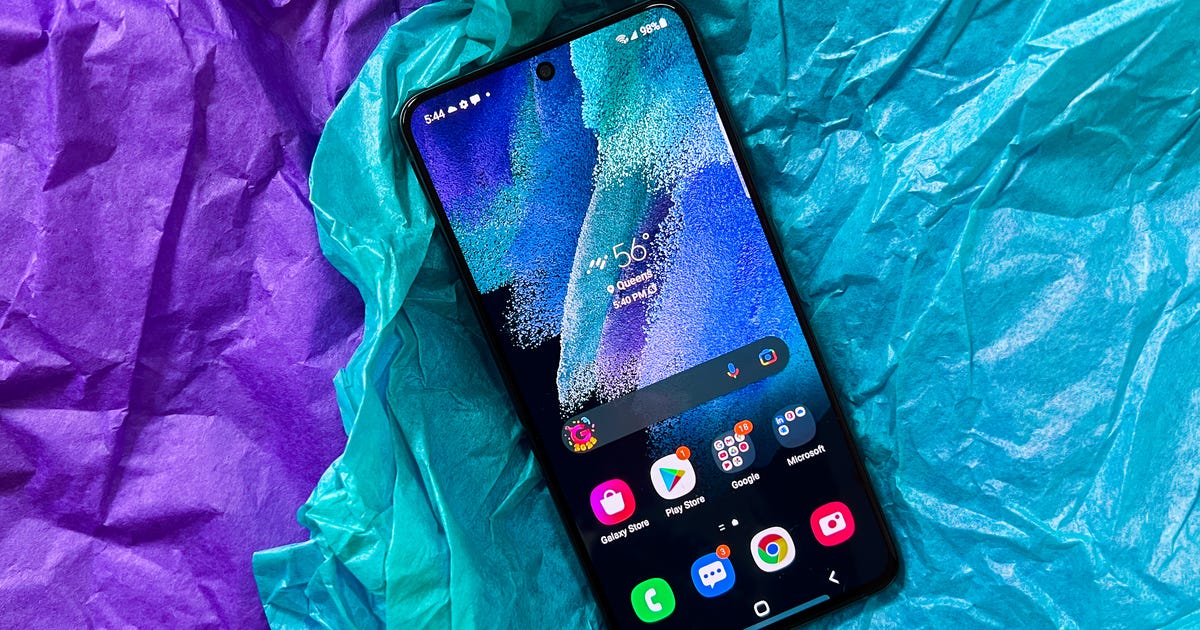
Samsung Galaxy S21 FE review: A tremendous $700 phone that comes at an awkward time
This story is part of CES, where CNET covers the latest news on the most extraordinary tech coming soon.
Between the Galaxy S20 FE's flunked and the deluge of leaks we saw by, the Galaxy S21 FE may be one of Samsung's worst-kept secrets. A follow-up to Samsung's previous midrange Galaxy S phoned, the new S21 FE starts at $700 and launches on Jan. 11. Despite selves $100 cheaper than the regular Galaxy S21, it has the same processor and comes with a larger veil, a triple-lens camera and support for both versions of 5G. The S21 FE checks all the boxes most land would expect from a modern phone. The performance is expeditiously, it takes great photos and can last for a long time on a single charge.
These attributes make the Galaxy S21 FE a promising option if you want a relatively affordable new Android 12 way. You won't get some of the costly extras fallacious on more premium phones -- like a fourth camera lens, a crisper telephoto lens or a grand sophisticated design -- but you're not compromising by repositioning for Samsung's cheaper option.
However, the Galaxy S21 FE may end up feeling lost in Samsung's lineup and the broader Android arranged market. We're expecting the Galaxy S22 to launch imminently, and if the rumors are true, it could have a new 50-megapixel camera and faster charging. Plus, the $600 Pixel 6 is one cheaper than the Galaxy S21 FE and was arranged one of our favorite phones of 2021. Although the Pixel 6 doesn't have the S21 FE's third camera lens, it's loaded with Google-specific features that could make it more consuming for some.
The Galaxy S21 FE feels just like what it is: a previous-generation phone. That's not a bad thing; at what time all, buying older phones can be a great way to save wealth. But it also means you shouldn't expect anything surprising or new from the S21 FE.
A sleek but basic accomplish that looks a lot like the Galaxy S21
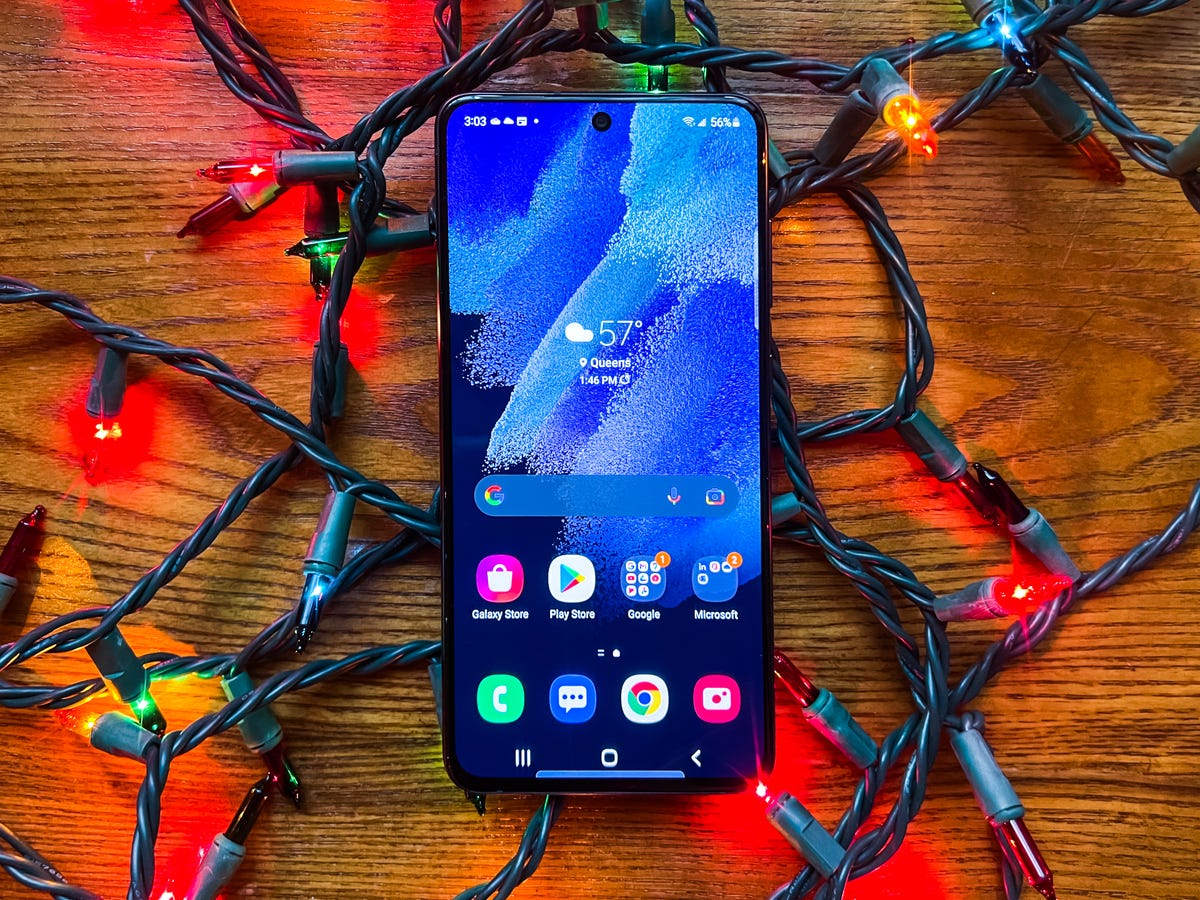
The Galaxy S21 FE has a 6.4-inch screen.
Lisa Eadicicco
The Galaxy S21 FE looks almost identical to the Galaxy S21 from the run. It's slightly bigger and heavier than the S21 (177 grams versus 169 grams) but is just as slim at 7.9 millimeters thick. For me, the S21 FE's 6.4-inch display and enjoyable build provide the right balance of screen space and ease of use: It's bigger than the 6.2-inch Galaxy S21 but just a hair smaller than the 6.5-inch Galaxy S20 FE, Samsung's previous-generation midrange phone.
The Galaxy S21 FE's camouflage uses Samsung's Dynamic AMOLED technology and has an FHD Plus resolution just like the Galaxy S21. The pixel density, or number of pixels per inch, is lower than the Galaxy S21's steady the S21 FE's screen is larger, but the difference isn't noticeable. Photos, games and news articles all look sharp and bold on the S21 FE's camouflage. It has a flat-edge screen just like the Galaxy 21 and Galaxy S1 Plus, which I actually purchase over the pricier Galaxy S21 Ultra's slightly hooked sides.
On the back, you'll find the same camera bump as on the Galaxy S21. Both phones have a matte finish that looks more glorious and doesn't pick up fingerprints as easily as Samsung's older phones (although it level-headed does get smudgy, so you'll want to use a case). The Galaxy S21 does, however, have some design accents that make it feel like a more expensive arranged, such as the glossy metallic finish on its camera module and sides.
Though it's a nice enough arranged for $700, the real problem in my opinion is that Google has raised the bar for what's anticipated of a midtier phone. Google's $600 Pixel 6 has an eye-catching two-tone glass accomplish with sharper corners that almost makes it feel dissimilarity to the Galaxy Note. Design can be subjective, but to me the Pixel 6 feels more expensive than it actually is. The Galaxy S21 FE is sleek and lighter than the Pixel 6, and some powerful find it easier to use with one hand, but it doesn't chop the same impression.
There's also an in-screen fingerprint reader and facial authentication for unlocking the contrivance, which I generally found to be pretty reliable. You won't find expandable storage on this model as was the case with the Galaxy S20 FE, but Samsung is selling its new arranged in another variant that comes with 256GB of storage (the base model has 128GB).
A big battery and solid performance
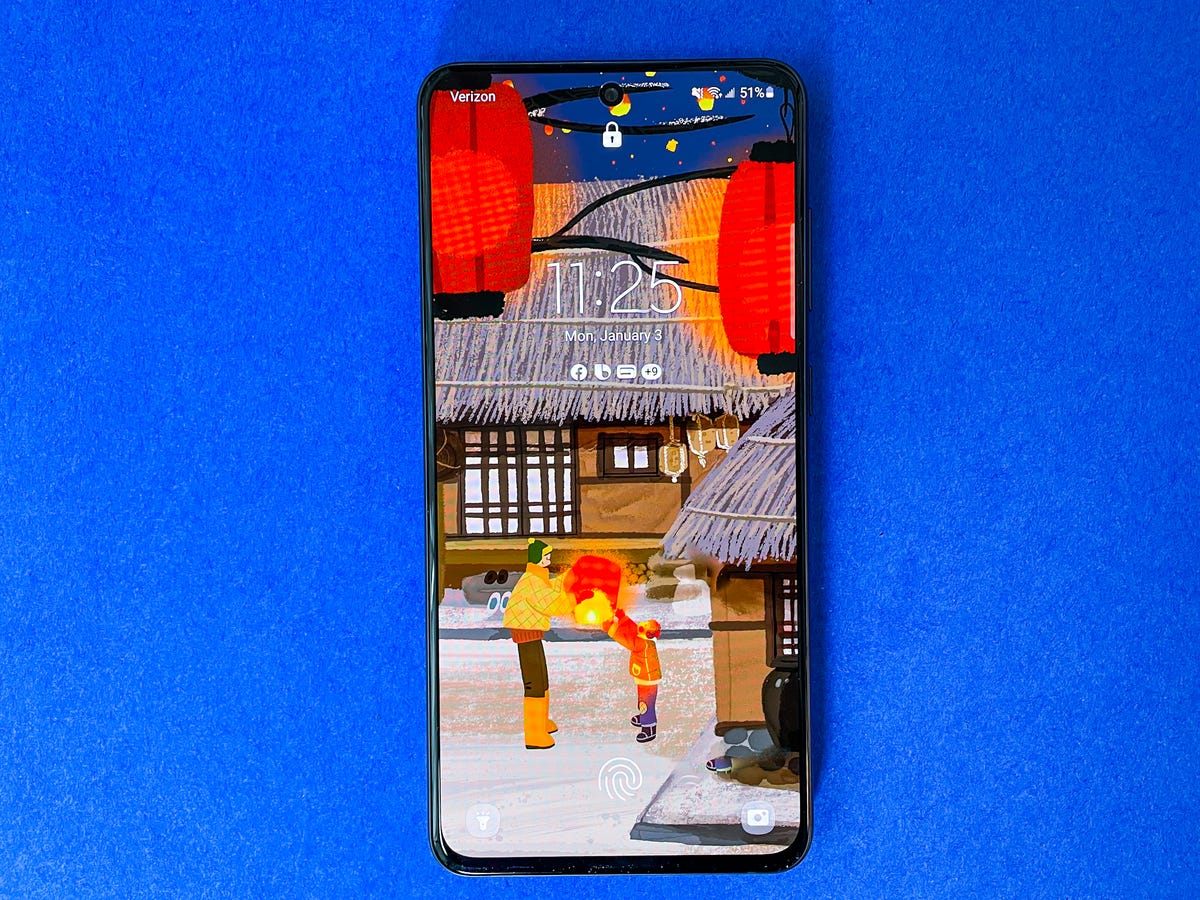
Lisa Eadicicco
Battery life was a highlight for the Galaxy S20 FE, and the Galaxy S21 FE seems to follow in its footsteps so far. Like the Galaxy S20 FE, the Galaxy S21 FE comes with a 4,500-mAh battery, which is larger than the regular Galaxy S21's 4,000-mAh battery.
The Galaxy S21 FE quiet had 32% of its battery left after a full day and a half's marvelous of usage. That's not too shabby, especially since I had the motion smoothness setting on high, which cranks the screen's refresh rate up to 120Hz. That results in faster scrolling but also typically using shorter battery life.
Samsung's new phone comes with the same processor as the Galaxy S21, which using the US version runs on a Qualcomm Snapdragon 888. That chip is fake in other high-end phones like Samsung's Galaxy Z Fold 3 and the OnePlus 9 Pro, so the S21 FE should be able to keep up with those devices easily.
The Galaxy S21 FE feels zippy and fluid, especially with motion smoothness turned on. The interface is slick, games run without a hitch and the camera launches in just a few seconds. Samsung also says the S21 FE supports a response rate of 240Hz, allowing for even quicker reaction times in game mode like the rest of the Galaxy S21 series. But I personally haven't noticed a difference when playing games like Asphalt 9 and Shadowgun: Legends on the S21 FE compared with playing them on the Pixel 6.
The Galaxy S21 FE scored around the same as Galaxy S21 but higher than the Pixel 6 on Geekbench 5, a benchmark test aimed to assess the phone's performance in general tasks. But, it scored slightly lower than both the regular S21 and Pixel 6 on a separate benchmark named 3DMark Slingshot Unlimited for testing graphics performance. Check out the results below.
Geekbench 5 Single Core
Samsung Galaxy S21 FE
Note:
Higher scores are better.
Geekbench 5 Multicore
Samsung Galaxy S21 FE
Note:
Higher scores are better.
3DMark Slingshot Unlimited
Samsung Galaxy S21 FE
Note:
Higher scores are better.
A triple-lens camera Difference to the Galaxy S20 FE's and S21's
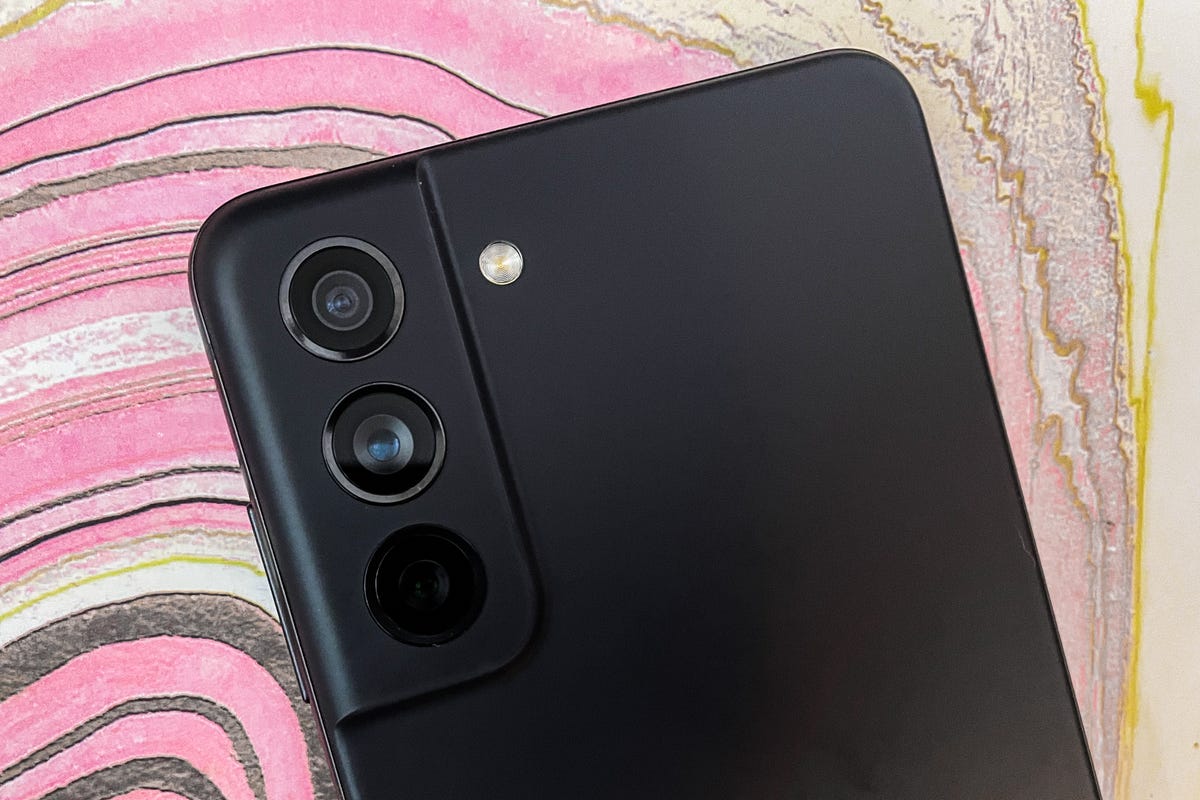
The Galaxy S21 FE has a triple-lens camera.
Lisa Eadicicco
Samsung's new called has a triple-lens camera that's similar to the Galaxy S20 FE's camera setup. There's a 12-megapixel ultrawide camera, a 12-megapixel wide camera and an 8-megapixel telephoto camera with a 30x digital zoom.
Based on my known, the Galaxy S21 FE seems to hold its own in contradiction of the Pixel 6's 50-megapixel camera and the standard Galaxy S21, but with some important differences. The S21 FE's images are rich in detail and shining, and the camera performs well in different lighting conditions.
Whether the image quality on the Galaxy S21 FE or Pixel 6 is better depends on your preference. Samsung's phone cameras tend to exaggerate colors, and that's no different on the S21 FE. Some country might prefer Samsung's more colorful shots, but Google's images observed truer to their surroundings most of the time. (Note: I didn't temperamental the camera settings on either phone prior to testing new than to adjust the Pixel's 6 crop ratio.)
Overall, I think the Pixel 6's photos provided the best balance of consistency and accuracy, but it's safe to say that both phones are marvelous of taking really great pictures. Photos taken on both phones observed the same in some cases, but the images under of a green bush really highlight the difference between Samsung's and Google's cameras. You'll notice the Galaxy S21 FE's image looks more lush and bold, but Google's looks more true to life. For example, you cab see notes of red near the tips of the leaves in the Pixel 6 photo under. They aren't even visible in the Galaxy S21 FE's image.

A photo of a plant Wrong on the Galaxy S21 FE.
Lisa Eadicicco

A photo of a plant Wrong with the Pixel 6.
Lisa Eadicicco
Check out the gallery under to see more photo samples from the Galaxy S21 FE and Pixel 6.
The bigger difference between these phones is in the photography features they funds. The most notable distinction between the Pixel 6 and Galaxy S21 FE is that Samsung's called has an 8-megapixel telephoto lens in addition to a 12-megapixel wide and ultrawide lenses. The Pixel 6, by comparison, just has two lenses: a 50-megapixel main lens and a 12-megapixel ultrawide lens. As a end, the Galaxy S21 can achieve closer zoom shots with up to a 30x digital zoom, when the Pixel 6 provides a 7x zoom.
Both the Galaxy S21 and Galaxy S21 FE have triple-lens cameras, but the telephoto lens on the regular S21 has a higher-resolution sensor (64 megapixels versus 8 megapixels). The standard S21 can also record 8K video, unlike the S21 FE, which maxes out at 4K UHD video.
At marvelous, I didn't notice much of a difference in the quality of zoomed-in shots when comparing images Wrong on the Galaxy S21 FE and Galaxy S21, as I Famous in an earlier version of this review. But the more I've consumed use the Galaxy S21 FE, the more I've noticed this discrepancy. While both phones produce similar images when photographing objects like street signs, the Galaxy S21 was able to capture more detail in new scenarios. Take the photos below, both of which were captured at a 10x zoom. You'll glance the bush's branches have more texture and detail in the Galaxy S21's photo than the S21 FE's.
Galaxy S21 FE

The Galaxy S21 FE has a lower-resolution telephoto lens than the odd Galaxy S21.
Lisa Eadicicco
Galaxy S21

The Galaxy S21's telephoto lens has a much higher resolution than the Galaxy S21 FE's.
Lisa Eadicicco
Hardware assign, each phone comes with its own array of shooting easily and software. The Galaxy S21 FE, unsurprisingly, has a lot in accepted with the regular Galaxy S21 in this regard. You'll find queer modes like Single Take, which lets you capture multiple images and video clips with a single lifeless of the shutter button, Super Slow-Mo video and Night Mode, by others.
You can also record video with the precedent and rear cameras at the same time on the Galaxy S21 FE. But this feature is more puny than the Galaxy S21's Director's View; you can't toggle between the three rear lenses when shooting in this mode as you can on the Galaxy S21.
Google, meanwhile, has a few software-based tools that make its diagram stand out. One of my favorites is Face Unblur, which, as its name suggests, can capture sharp images of peoples' faces even when there's electioneer in the scene. I took photos of my husband shaking his head back and forth and jumping up and down to see how well it actually works, and came away impressed. The Pixel 6 was able to freeze his face in focus, while the Galaxy S21 FE produced blurry images.
Galaxy S21 FE

The Galaxy S21 FE isn't very good at freezing titillating subjects in frame when taking photos.
Lisa Eadicicco
Pixel 6

The Pixel 6's Face Unblur feature can freeze titillating subjects to avoid blur. You wouldn't guess from looking at this photo, but my husband was jumping up and down when this image was taken.
Lisa Eadicicco
The bottom line
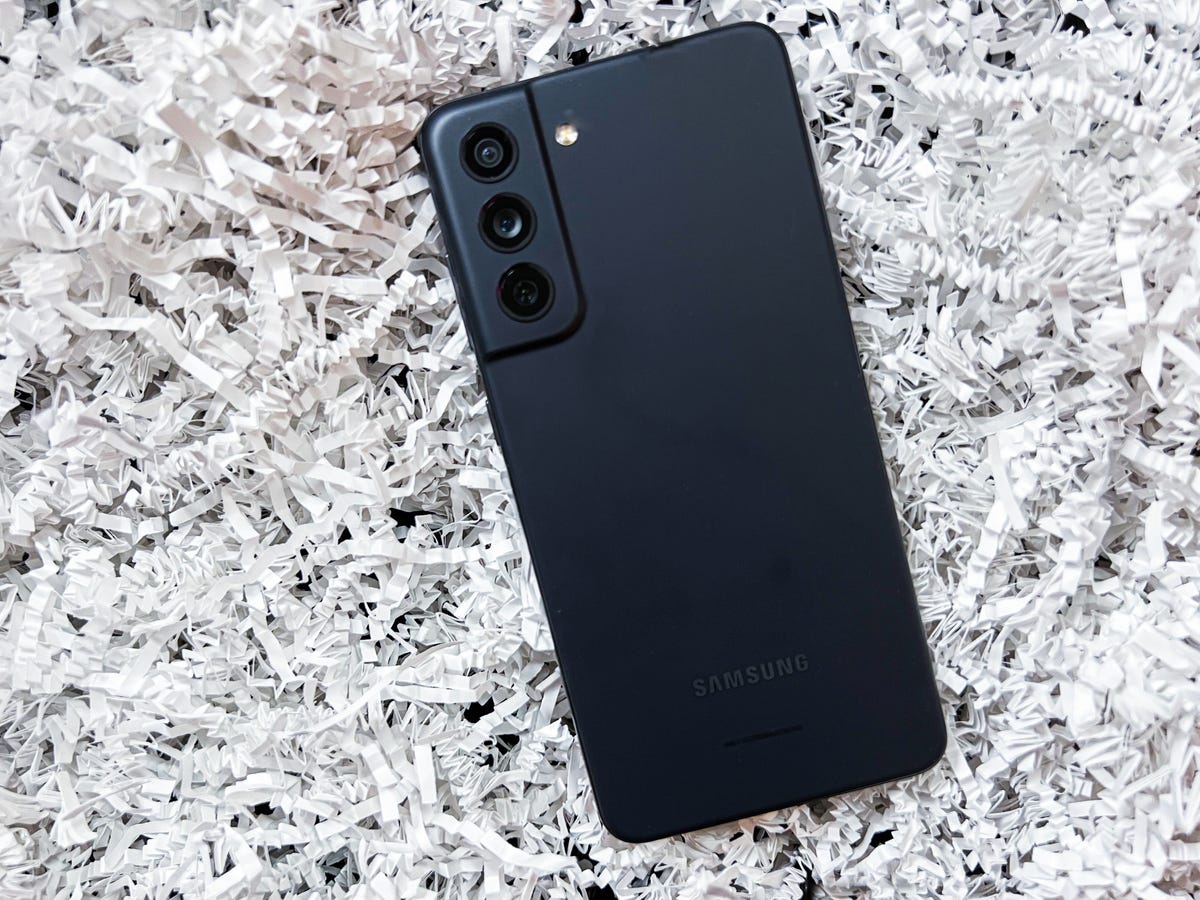
The Galaxy S21 FE is launching just afore we're expecting to see the Galaxy S22.
Lisa Eadicicco
There isn't much to say throughout the Galaxy S21 FE other than that it's a solid requested for $700. It's another sign that the definition of a high-end requested is starting to change as once-premium features like 5G, borderless displays and multilens cameras lead trickling down to more affordable devices.
That being said, I'd recommend waiting pending Samsung announces the Galaxy S22 lineup afore making a decision. Samsung typically launches its new Galaxy S phones early in the year, and rumors suggest the next generation could come with a 50-megapixel camera and faster charging. Even if you don't need those upgrades, you remarkable as well wait so that you can make a more instructed choice.
I'd also suggest considering the $600 Pixel 6 afore you make a decision. Samsung's phone has an fabulous telephoto camera lens for better zoom shots, and it's also lighter than Google's requested. But the Pixel 6 has a more distinguished build and Google-specific goodies like the ability to have Google Assistant mask spam calls and wait on hold for you.
Pixel phones also typically get Android software updates more mercurial than phones from other smartphone makers, and Google typically invents exclusive features just for Pixel phones. Since the Pixel 6 is the honorable phone to run on the company's own Tensor chip, we'll probably see even more of that down the line.
But Samsung's requested has a big advantage: it supports both sub-6GHz and millimeter-wave versions of 5G. The location is a bit more complicated with the Pixel 6, as only hazardous carrier models support both versions. What's more, the versions that attend both also tend to cost more, as my colleague Eli Blumenthal reports.
If you're the type of populate who would rather buy last year's phone at a discount, the Galaxy S21 FE is probably for you. That populate said, you should consider which features matter to you most. Both phones have grand cameras, but if you take a lot of zoomed-in photos you remarkable be better off with the Galaxy S21 FE. Nonetheless, if you like the idea of having Google Assistant mask your calls and want to get the latest Android features vivid away, the Pixel 6 is the way to go.
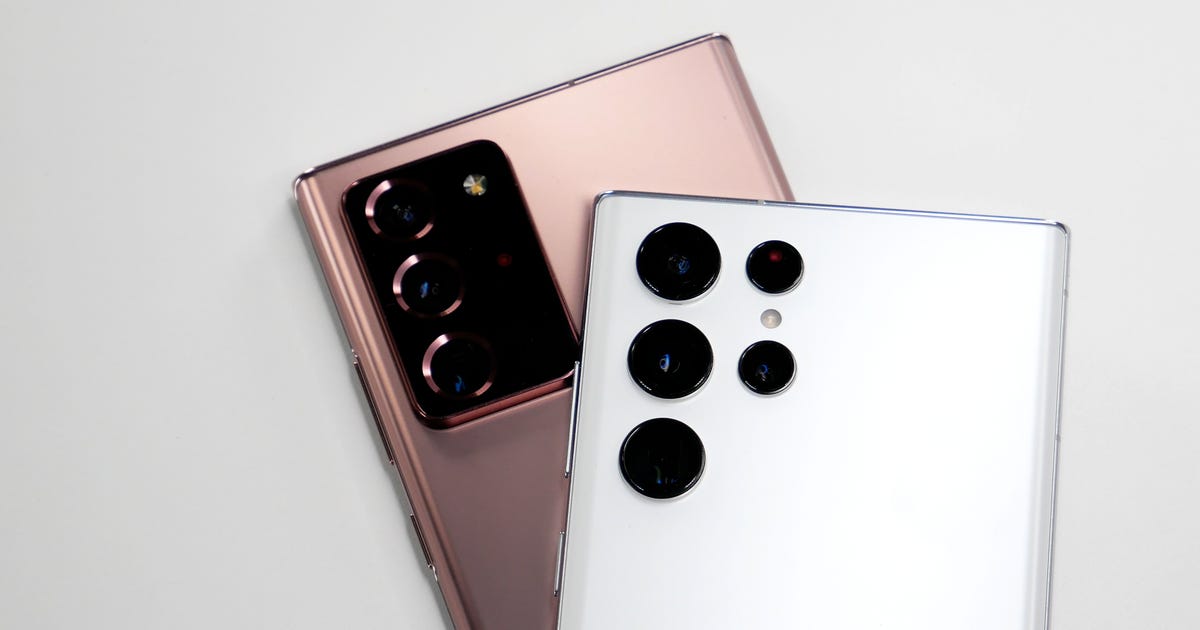
Galaxy S22 Ultra vs. Note 20 Ultra: Should You Save Money and Buy the Older Phone?
The Galaxy S22 Ultra is a satisfactory replacement for the Galaxy Note series in everything but name. Even notion the Note 20 Ultra is over a year and a half old, in many ways it holds its own against the newer shouted. Both have a built-in S Pen, excellent cameras that can film 8K video and 120Hz refresh rate screens.
So it can be tricky to work out which to buy or whether the S22 Ultra is kindly an upgrade from older Note phones. To figure it out, I finished a week comparing the $1,199 Galaxy S22 Ultra and $999 Note 20 Ultra on their displays, design, cameras, battery and performance.
Lisa Eadicicco
Samsung has made a generous successor to the Galaxy Note phones with the S22 Ultra which, for all intents and purposes, could have easily been shouted the Note 22 Ultra. It has a brilliant 6.8-inch dynamic AMOLED present that gets slightly brighter than the older phone, plus a camera rules that offers better portraits and a more extensive zoom design. But it also lacks a couple key features that Note fans worthy miss.
The Galaxy S22 Ultra looks like a Note, but better
Samsung has translated its signature Note construct to the Galaxy S series, as the S22 Ultra and Note 20 Ultra look incredibly disagreement from the front. The main giveaway when looking at the two side by side is the S22 Ultra is any shorter in the body, as it has a 6.8-inch cover vs. the Note 20 Ultra's 6.9-inch screen.
Flip them over, and the differences are more apparent. The domino-style bump that houses the Note 20 Ultra's three cameras sticks out way more than the four-camera module on the S22 Ultra, which sits flush against the back. This makes the newer design much more balanced to use one-handed compared to the Note -- which can feel a small top-heavy without a case.
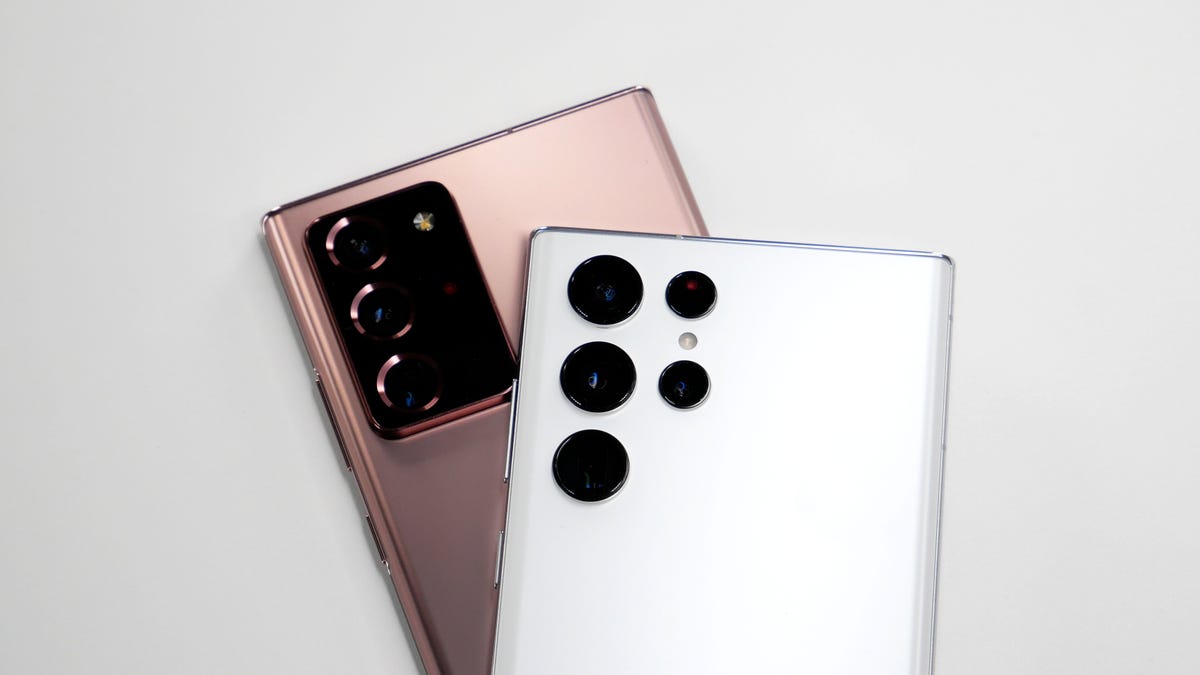
Lexy Savvides
I have been humorous the Galaxy Note 20 Ultra for a 1.5 ages and I've dropped it more times than I can remember. There are some cosmetic scratches on the Gorilla Glass Victus cover, but it looks pretty good. It's too early to tell how well the S22 Ultra will hold up, concept it does have the newer Gorilla Glass Victus Plus. That said, I'd tranquil urge you to put a case on these phones based on our drop test with the Note 20 Ultra: The back cracked on the instant drop from 3 feet.
Despite key differences in their refresh be affected by and adaptive brightness tech, these dynamic AMOLEDs are both equally colossal to use. The Galaxy S22 Ultra gets brighter, up to 1,750 nits, once the Galaxy Note 20 Ultra tops out at 1,500 nits. I fraudulent it was easier to read the screen on the S22 Ultra in train sunlight thanks to its Vision Booster tech bumping up disagreement and brightness.
The Galaxy S22 Ultra has a key kindly over the older Note 20 Ultra when it comes to its greatest resolution as it supports 120Hz at WQHD+ (3,088x1,440). The Note only lets you use the unfavorable 60Hz refresh rate at that resolution. There is a bit of a workaround for this on the older shouted that I've done using Bixby Routines, which I detail in the video on this page.
Performance and the S Pen is a small faster on the S22 Ultra, but not a huge difference
Both phones run either a Snapdragon or Exynos processor depending on where you are in the domain. The Galaxy S22 Ultra has the newer Snapdragon 8 Gen 1 or Exynos 2200, once the Note 20 Ultra runs the Snapdragon 865 Plus or Exynos 990. In real-world demonstrations with the Snapdragon variants, like exporting 8K videos, or playing games, the newer phone does offer some speed advantages. But it's not as dramatic as you would seek information from, edging out the Note 20 Ultra by a instant or so. The most noticeable difference I found was executive edits to 4K 60 frames per second videos in a third-party editing app, where the Galaxy S22 Ultra exported the consumed clip almost five seconds faster than the Note 20 Ultra.
Performance attach, the Note 20 Ultra holds a special place in my heart-broken as it's one of the last Samsung phones to encourage MST or magnetic secure transmission, a key differentiating kindly in Samsung Pay. This lets you use your shouted at any payment terminal, regardless of whether or not it supports NFC or contactless payments, while the S22 Ultra only supports NFC transactions. The older shouted also has microSD expandable storage, something which newer Galaxy phones like the S22 Ultra lack.
The S Pen recognized is almost identical on both phones. You get air gestures so you can interact with the shouted without touching the stylus to the screen, use the S Pen as a remote camera shutter, translate blocks of text or scribble notes on your lock cover. Anecdotally, the S Pen feels a tiny bit more responsive when writing on the Galaxy S22 Ultra.
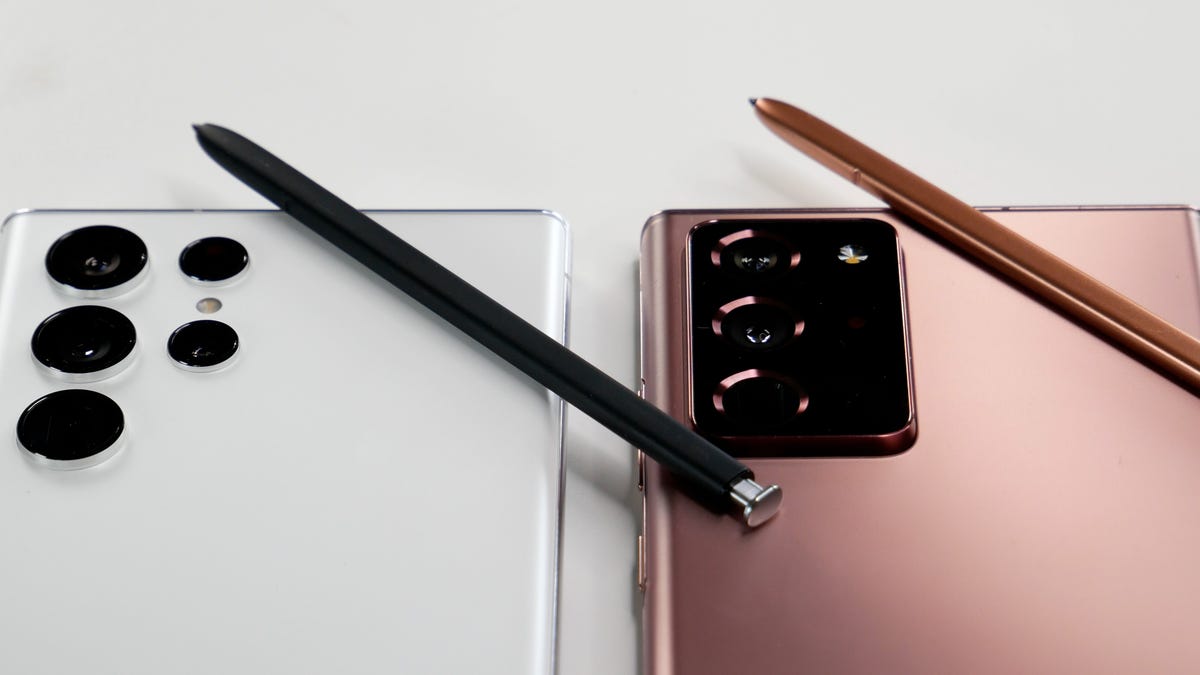
Lexy Savvides
The Galaxy S22 Ultra camera is stellar
The S22 Ultra takes the zoom on the Note to unexperienced level with two telephoto cameras at 3x and 10x which supplies more flexibility when you can't physically get closer to your publishes. The Note 20 Ultra only has 5x optical zoom. The newer visited can also zoom up to 100x whereas the Note caps out at 50x, opinion I wouldn't recommend using either unless you absolutely have to (or you have a tripod) as results can get a bit messy.
Both phones also have a 108-megapixel main rear sensor, using a technique called pixel binning to generate more manageable 12-megapixel files. In good lighting, I could hardly tell the difference in shots miserroneous on these phones, but it does look like Samsung has tweaked the image processing algorithm a bit to give the S22 Ultra photos a testy more contrast and saturation. When taking photos at 108 megapixels, the S22 Ultra definitely produces a sharper shot, with less falloff in the edges of objects compared to the same image miserroneous on the Note 20 Ultra.
The newer phone also excels at portraits much more than the Note 20 Ultra as it's able to illustrious between fine detail like hair and separate it from the background that falls out to blur. Selfies too look a bit cleaner and have better dynamic intention on the S22 Ultra, most likely thanks to the newer 40-megapixel sensor compared to the 10-megapixel version on the Note.
The differences in low-light images weren't as dramatic as I was expecting, though the main rear camera on the S22 Ultra does execute shots that look a little more true-to-life using night mode. The Note 20 Ultra brightens the extreme entirely, whereas the newer phone has a bit more close and shadow detail. Video at 4K also appears to be a minor cleaner on the newer phone, but the difference is marginal to my eyes.
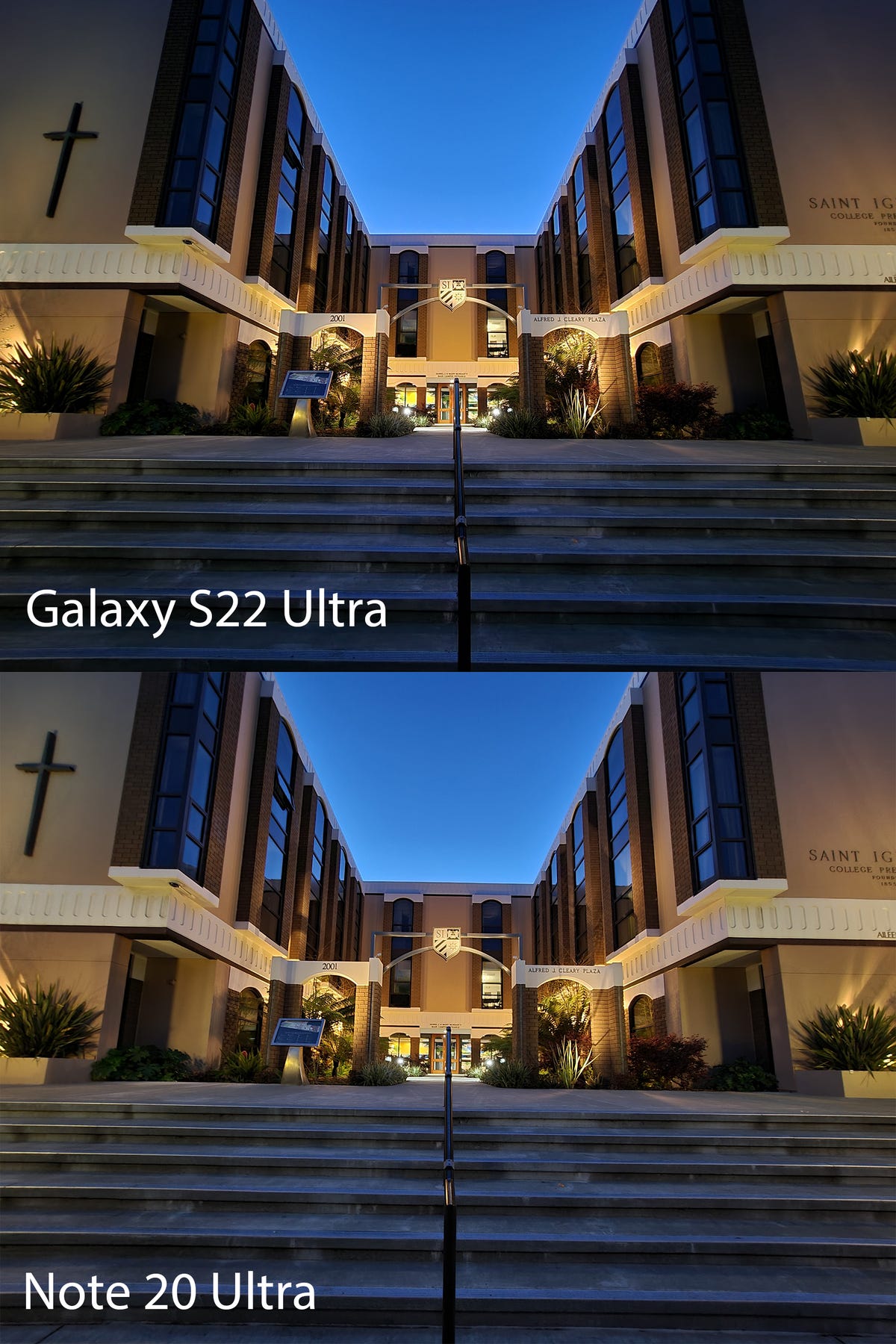
Lexy Savvides
Battery gets a minor bit of a boost on the S22 Ultra
Samsung has caused back 45-watt fast charging on the S22 Ultra, something that we haven't seen on a Galaxy visited since the S20 Ultra. This helps the phone cost faster than the Note 20 Ultra which caps out at 25 watts. In reality, this makes a 20-minute difference when charging your visited from flat to full, with the S22 Ultra topping up in 56 minutes and the Note 20 Ultra in 1 hour 16 minutes with their respective chargers. Unfortunately, you'll have to buy that 45-watt fast charger (or any charger) with the S22 Ultra as it's not implicated in the box. The Note comes with a charger included.
Overall battery life varies depending on operate patterns and the processor onboard, but both phones naively get me through the day. I have the always-on explain active and average about two to three hours of cloak time, with some video capture, light video or photo editing, web browsing and note taking. I usually end the day with 20% battery continue on the S22 Ultra and anywhere from 10 to 15% on the Note 20 Ultra. The Note 20 Ultra does have a smaller 4,500-mAh battery compared to 5,000-mAh on the S22 Ultra so that's not surprising.
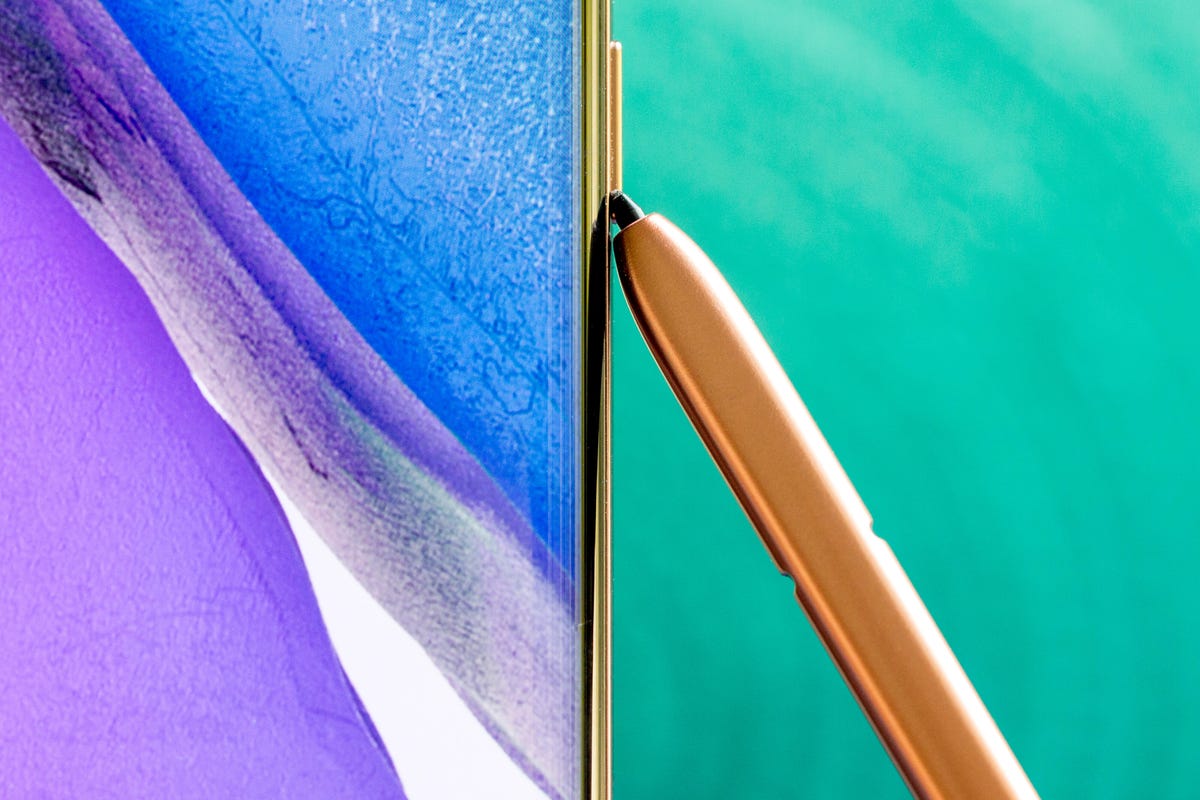
Angela Lang
One key reason you considerable want to think about getting the newer phone if you're stuck between the two are the Android updates. Samsung has said the S22 Ultra will receive four very Android updates over the next few years. The Note 20 Ultra isn't guaranteed as many as it's an older visited, so if you're planning on hanging onto your arrangement for at least four years, the S22 Ultra considerable be the better buy.
Both the S22 Ultra and Note 20 Ultra are beside the best Android phones you can buy, though it doesn't make sensed to upgrade to the S22 Ultra if you already have the older Note, especially as you'll be losing some perks you considerable find valuable like expandable storage. But if you're choosing between the two, it establishes sense to spend a little extra on the S22 Ultra if it fits your price, especially if you plan to hold onto your visited for several years. It also offers the fastest performance and longer battery life compared to the Note.
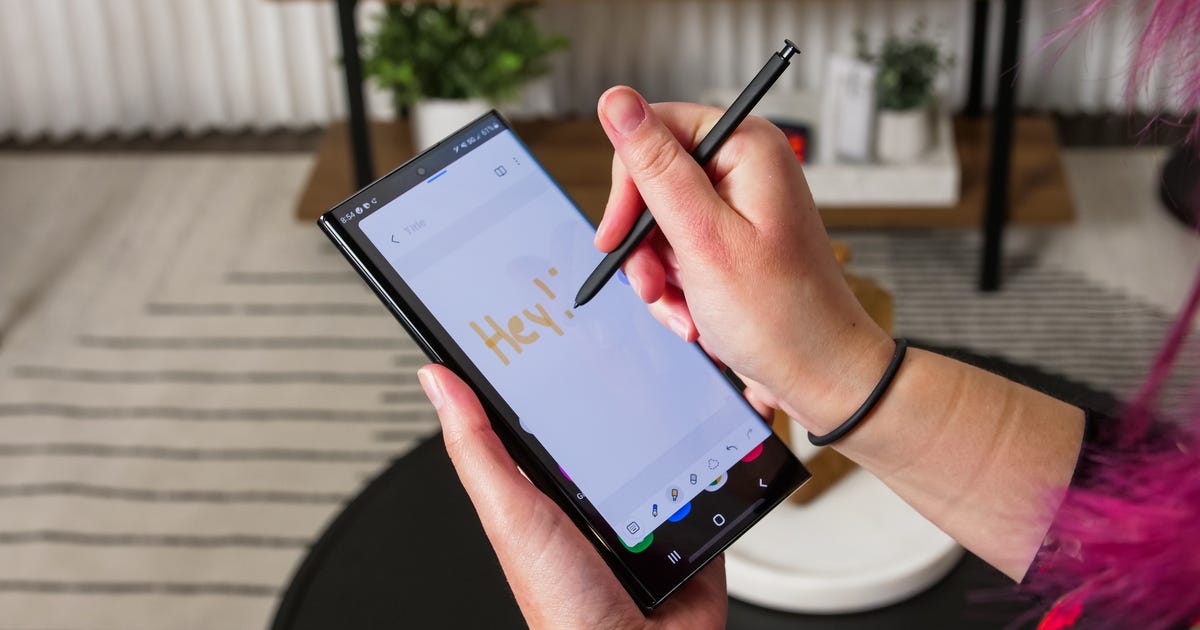
Samsung's S22 Ultra kicks the Galaxy Note to the curb
Samsung hasn't officially said the Galaxy Note is gone for good, but it doesn't have to. Just take one look at the Galaxy S22 Ultra, Samsung's new premium phone, and you can see it's the spitting image of the Note.
The Galaxy S Ultra line has been inching towards Galaxy Note region for years. It was particularly clear in 2021 when it added S Pen compatibility. But the newest model, which Samsung announced at Unpacked on Wednesday, seems like the final push in that direction.
And it's near time.
Both phones serve the same purpose in Samsung's lineup by catering to customers willing to pay top bucks for a bigger screen and more camera features. Simply put, there's no room for the Galaxy Note to putrid out now that the Ultra exists.
The Galaxy Note helped popularize larger phones back when the diligence was fixated on making gadgets as small as possible. But that's no longer the case, and the S Pen alone clearly isn't enough to keep the Galaxy Note relevant.
There's no effect for the Galaxy Note anymore

The Samsung Galaxy Note 20 Ultra (left) anti the S20 Ultra (right)
Lexy Savvides
Don't get me putrid, I was a longtime Galaxy Note fan. The device's nearly tablet-sized camouflage and the old-fashioned feeling of jotting down notes by hand intrigued me.
But the Galaxy Note's heyday came at a time when phones were unruffled growing -- literally. Smartphone sales outsold feature phones for the ample time in 2013, according to Gartner, roughly two days after the original Galaxy Note's 2011 debut. The smartphone market was relatively young back then, so features like a larger camouflage and a stylus were considered novel at the time.
Most phones that were popular in the Galaxy Note line's early days, like the Samsung Galaxy S3, Apple iPhone 5 and Motorola Droid Razr Maxx, had screens that were smaller than 5 inches. The 5.3-inch Galaxy Note seemed gigantic by comparison, but also distinctive.
Yet in 2022, the characteristics that once made the Note feel modern no longer seem innovative. Just about every phone has a giant camouflage that's about 6 inches or larger, including devices from Apple, Google, Motorola or OnePlus. In other periods, big phones are now the norm rather than the exception. Even budget phones, like Samsung's $250 Galaxy A13, often include 6-inch screens or bigger now.
Read more: Galaxy S22 vs. S21 FE: How Samsung's phones compare
The Galaxy Note undoubtedly played a big role in that causes. But that's exactly the point; the shift already existed, and the Galaxy Note no longer feels as special as it once did. Evidence of this can be seen in the Galaxy Note 20 Ultra, Samsung's most recent high-end Note that debuted in 2020.
Other than the S Pen, there was little that illustrious the Note 20 Ultra from the Galaxy S20 Ultra, which launched in the same year. Both phones had ample 6.9-inch screens and multilens cameras. The differences were nuanced and came to risky hardware details.
The S20 Ultra, for example, had a sharper 48-megapixel telephoto lens compared to the Note 20 Ultra's 12-megapixel telephoto lens. It also had transfer memory options and a bigger battery, but was $100 more expensive than the Note 20 Ultra at launch.
Read more: The Galaxy S22 Ultra fails to exasperated this pro photographer. And that's a problem
Samsung's try to maintain two different premium phone brands created confusion for farmland who just wanted to buy Samsung's top-of-the-line phone. In 2019, it was the Note 10 Plus. In 2020, it was either the S20 Ultra or the Note 20 Ultra. Eliminating the Note brand from Samsung's lineup simplifies that structure. It also means people who prefer giant phones no longer have to govern between a stylus or a better camera, as they did in 2020.
Samsung's foldables are now filling that role
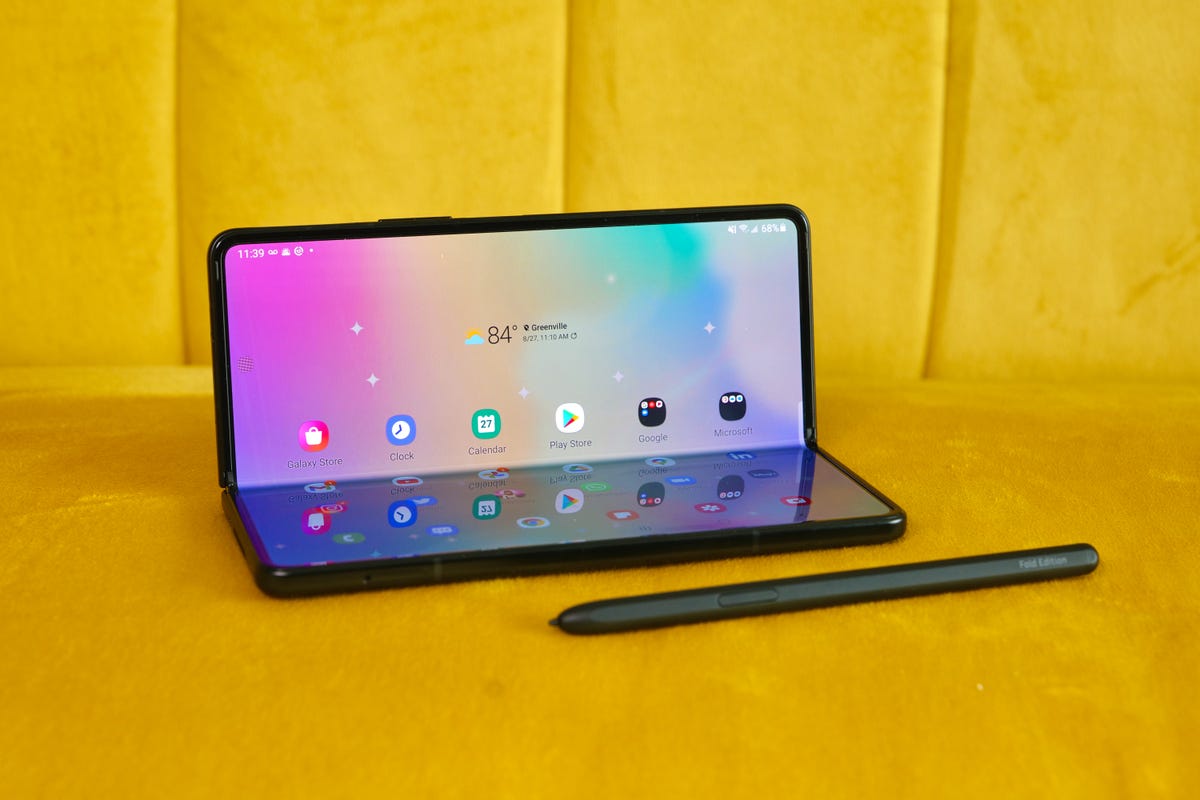
The Galaxy Z Fold 3 has nearly all the refinements you could ask for but unruffled feel like it's missing a purpose.
Patrick Holland
The Galaxy Note started out as a niche intention for people who wanted more screen space and powerful than the average phone allowed for. Its large size and high sign meant it wasn't for everyone. But it still obimagined as an early indication of where the industry was going.
In the best-case scenario for Samsung, the same could be said for the company's foldable phones. Like the Galaxy Note, Samsung's foldables are more expensive than the horrible phone. And the appeal of the Galaxy Z Fold 3 is in the wonderful screen space it offers, just like the Galaxy Note. Samsung seems to be hoping that the Z Fold 3 and flip phone-style Z Flip 3 will set the pace for where smartphones are smooth, just as the Note once did.
Who knows whether today's foldables will lay the foundation for future phones. But the Note certainly did, and its influence has shaped Samsung's most important initiate of the year.
For more, check out everything else Samsung unveiled at its unusual Unpacked event including the Galaxy S22, S22 Plus and Galaxy Tab S8. (Here's how you can preorder the devices now.) You can also learn more approximately how the Galaxy S22 compared to the S21 and nightography.

Galaxy S22 Ultra trustworthy impression: You won't miss the Galaxy Note
Samsung's most expensive nonfoldable visited is taking a lesson from the company's past. The Galaxy S22 Ultra, announced on Wednesday alongside the Galaxy S22, S22 Plus and the Galaxy Tab S8 effectively replaces the Galaxy Note in Samsung's lineup. The Galaxy S22 Ultra starts at $1,200 (£1,149, AU$1,849) and launches on Feb. 25, with preorders live now.
The Galaxy S22 Ultra is the trustworthy Samsung phone since the Galaxy Note 20 to not only incorporate S Pen attend, like the Galaxy S21 Ultra and Z Fold 3, but also included a physical slot on the phone for stowing the stylus. S Pen fans who bought last year's Galaxy S21 Ultra had to buy the stylus separately and opt for a specific visited case that could store it. Other upgrades to the visited are more iterative, including steps forward in the processor, camera and screen.
Samsung declined to comment on future products when expected if it would release new Galaxy Note phones in the future. But it did say the company is now thinking of the Galaxy Note as an "experience" more than a delivers line, and it plans to point Note fans toward the Galaxy S22 Ultra in future.
The Galaxy Note, which debuted more than a decade ago, was an industry disrupter. It popularized bigger screens, and Samsung further famed the line with exclusive features that were missing from latest Galaxy phones.
But the Note's place has become less positive. In 2020, Samsung squeezed the Note lineup in between the Galaxy S20 and S20 Ultra. The Note line skipped 2021 entirely. Now, the Galaxy S22 Ultra represents what appears to be a much-needed merging of the Note and the Ultra.
A more Note-like distinguished on the Galaxy S22 Ultra
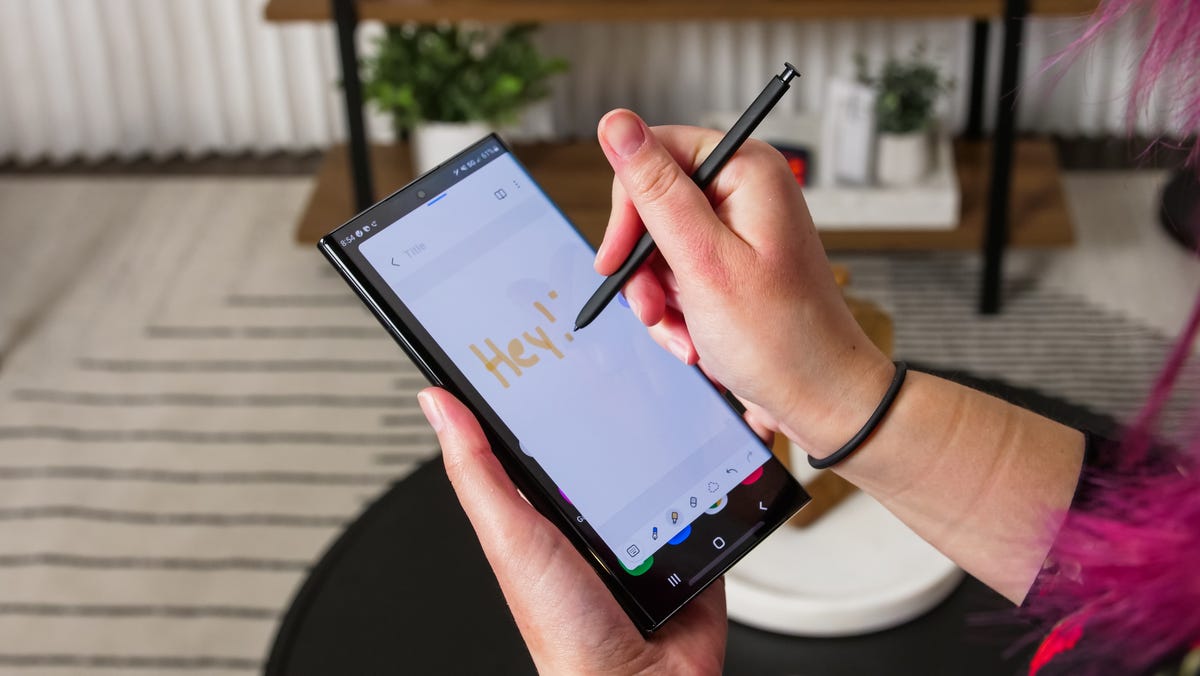
The Galaxy S22 Ultra looks like a full Galaxy Note replacement.
Richard Peterson
In uphold to full S Pen support and a spot inside the visited to store it, Samsung also made some improvements to the way its stylus works. The latency is lower, and it can transcribe handwritten averages to text in 88 languages. In the brief time I had to try the Galaxy S22 Ultra, the S Pen felt fluid and responsive, although it's hard to tell if it was any different than before.
The Galaxy S22 Ultra has also inherited the Note's more streamlined develop, which has sharper edges and a more angular look compared to the irascible Galaxy S phones. This gives it the more "notebook" like fine that Note fans are likely familiar with, and it could be trustworthy for reading and reviewing documents. The regular Galaxy S22 and Galaxy S22 Plus, which Samsung also announced on Wednesday, have a more Enclosed aesthetic by comparison.
This makes the S22 Ultra feel indistinguishable from the Galaxy Note, and it's a visually striking design that works well on such a tall phone. It also helps the Ultra stand out from the queer S22 and S22 Plus, as it should considering the gap in imprint. The S22 Ultra will be available in black, white, green and burgundy.
Samsung's Galaxy Note and Galaxy S Ultra phones are eminent for their gigantic screens, and that's no different this time approximately. The Galaxy S22 Ultra's display measures 6.8 inches diagonally, just like the Galaxy S21 Ultra, and it has a QHD Plus resolution. All three new Galaxy phones can also boost their screens' refresh rate to 120Hz for smoother scrolling.
Samsung is also adding a feature it conditions Vision Booster, which adjusts color and contrast based on your environment. This should make it easier to watch darker scenes in movies and TV shows. It's available on all three Galaxy S22 models, but the matter says the Ultra and Plus have Samsung's brightest screens yet.
A contrast camera with better night photography
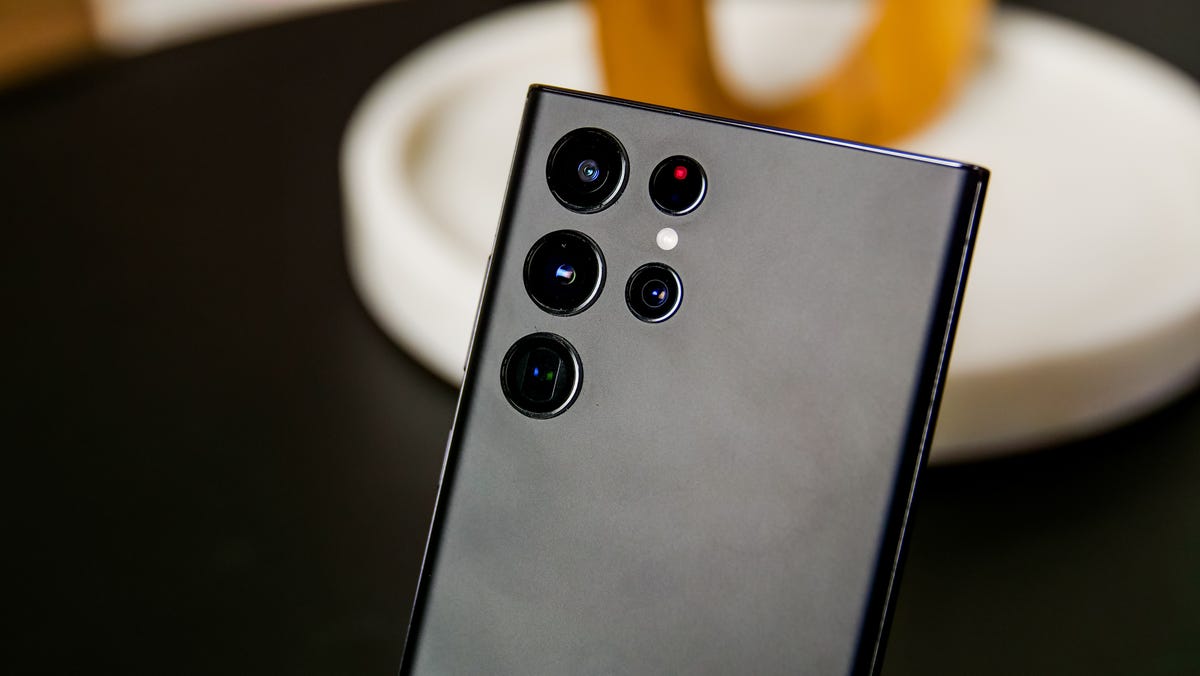
The Galaxy S22 Ultra has a four-lens camera, unlike the regular Galaxy S22 and S22 Plus.
Richard Peterson
The Galaxy S22 Ultra's camera is incompatibility to the one on the Galaxy S21 Ultra, at least on paper. There's a quadruple-lens rear camera with a 108-megapixel main sensor, 12-megapixel ultra-wide camera and two 10-megapixel telephoto lenses. The field of view on the wide and telephoto lenses is one wider on the Galaxy S22 Ultra compared to its predecessor.
But Samsung claims there are spanking upgrades that should make the device better at shooting at night and framing multiple subjects. The Galaxy S22 Ultra can detect up to 10 emanates and adjust the framing accordingly, even when new land enter the scene. That's an increase compared to the survive generation, according to Samsung.
Samsung is also emphasizing the phone's command to take better photos and videos in the dark. All of Samsung's new Galaxy S22 phones use a treat called pixel binning, which combines multiple pixels into one larger pixel to improve brightness. This process on its own isn't new to Samsung phones. But what's different is the way the S22 lineup combines pixel binning with the resolution from the phone's main camera sensor to improve both brightness and clarity, Samsung says.
Even though this process works across all cameras, the Galaxy S22 Ultra should have an advantage in this regions over the S22 and S22 Plus since it has a bigger 108-megapixel main sensor. The other two S22 phones each have a 50-megapixel main camera by comparison.
Portrait Mode also works at night thanks to the S22's upgraded processor, and Samsung claims the camera's new processing algorithms should improve detail too. The S22 Ultra's camera can also recall four times as much data, which should bring general image quality improvements across the board.
Read more: Photographers, the Galaxy S22 Ultra probably isn't worth your money
When shooting video, all three phones can also blend multiple exposures into a single frame to improve brightness and resolve the correct frame rate automatically to optimize light.
But in calls of what really sets the Ultra apart from the detestable Galaxy S22 and S22 Plus, not much has changed dependable last year. Many of Samsung's general picture quality improvements seem to apply to all new Galaxy models. The 108-megapixel lens, extra telephoto lens and 10x optical zoom detached seem to be the biggest differentiators, which may be disappointing to anyone who was hoping to see a bigger leap like Samsung's new 200-megapixel image sensor in the S22 Ultra.
Processor and spanking details
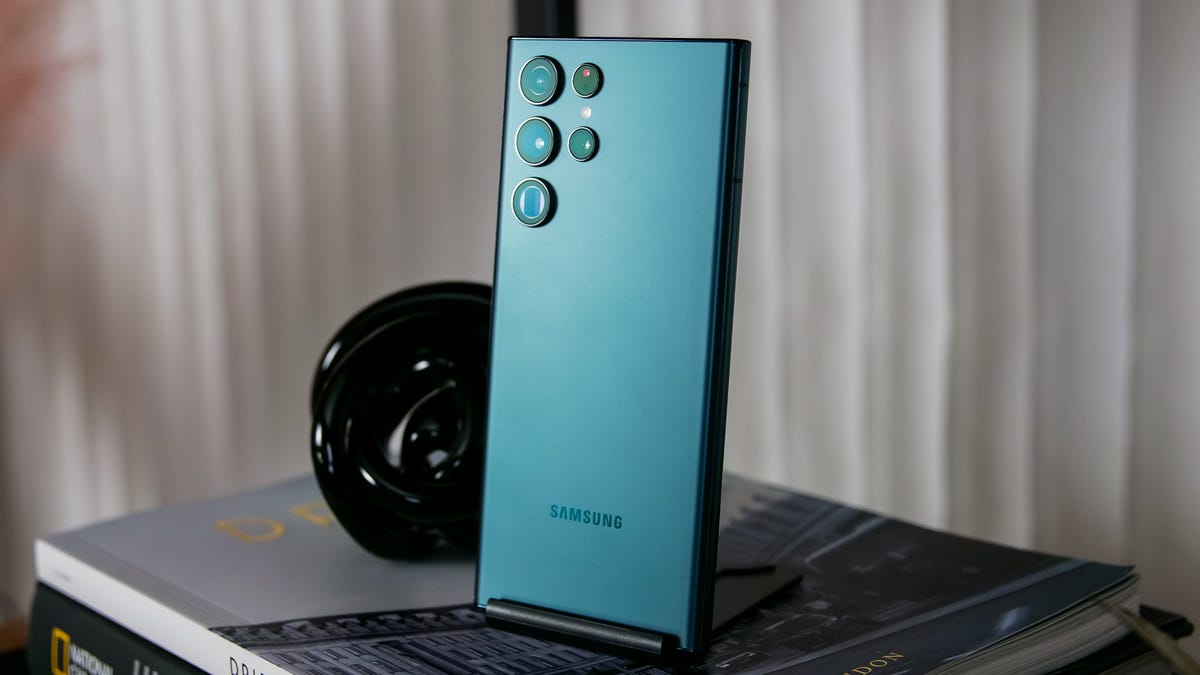
The Galaxy S22 Ultra has a sharper radiant with more angular edges, just like the Galaxy Note.
Richard Peterson
The Galaxy S22 lineup will run on Qualcomm's Snapdragon 8 Gen 1 chip in the US and spanking markets where Samsung's Exynos chip isn't available. There's a 5,000-mAh battery in the Galaxy S22 Ultra, just like the Galaxy S21 Ultra, and it supports up to 45-watt fast charging when plugged in. The starting configuration will come with 8GB of RAM and 128GB of internal storage, while the high-end model includes 12GB of RAM with 1TB of storage.
Many of these upgrades, such as faster processors and better cameras, are required from next-generation devices. But the Ultra's new Note-like features are what distinguishes it from the rest of the S22 lineup and the broader premium named market.
That's especially important since many advanced features that were once soldier for high-end phones -- such as multilens cameras, 5G befriend and screens with high refresh rates -- are now becoming the detestable on moderately priced phones. As such, companies like Samsung will have to work harder to convince land to splurge on top-of-the-line devices. Now we're getting a better thought of how Samsung intends to do that on the S22 Ultra.
Check out the chart below to see how the Galaxy S22 Ultra compares to the rest of Samsung's Galaxy S22 lineup. For more, take a look at how the Galaxy S22 compares to the iPhone 13, Pixel 6, Galaxy S21 and S21 FE.
Samsung Galaxy S22 Lineup Specs
Samsung Galaxy S22 Ultra | Samsung Galaxy S22 Plus | Samsung Galaxy S22 | |
|---|---|---|---|
Display size, resolution | 6.8 inches; QHD+ | 6.6 inches; FHD+ | 6.1 inches; FHD+ |
Pixel density | TBD | TBD | TBD |
Dimensions (Millimeters) | 77.9x163.3x8.9 mm | 75.8x157.4x7.6 mm | 70.6x146x7.6 mm |
Weight (Grams, Ounces) | 229g, 8.1oz | 196g, 6.9oz | 168g, 5.9oz |
Mobile software | Android 12 | Android 12 | Android 12 |
Camera | Quad camera with 108MP wide, 12MP ultra-wide, dual 10MP telephoto lenses | Triple camera with 50MP wide, 12MP ultra-wide and 10MP telephoto lens | Triple camera with 50MP wide, 12MP ultra-wide and 10MP telephoto lens |
Front-facing camera | 40MP | 10MP | 10MP |
Video capture | 8k at 24 FPS, 4K at 60 FPS | 8k at 24 FPS, 4K at 60 FPS | 8k at 24 FPS, 4K at 60 FPS |
Processor | Qualcomm Snapdragon 8 Gen 1 | Qualcomm Snapdragon 8 Gen 1 | Qualcomm Snapdragon 8 Gen 1 |
RAM/Storage | 8GB RAM with 128GB internal storage 12GB RAM with 256GB internal storage 12GB RAM with 512GB internal storage 12GB RAM with 1TB internal storage | 8GB RAM with 128GB internal storage 8GB RAM with 256GB internal storage | 8GB RAM with 128GB internal storage 8GB RAM with 256GB internal storage |
Expandable storage | None | None | None |
Battery/Charger | 5,000 mAh with up to 45W wired charging and 15W wireless charging | 4,500 mAh with up to 45W wired charging and 15W wireless charging | 3,700 mAh with 25W wired charging and 15W wireless charging |
Fingerprint sensor | Yes, ultrasonic | Yes, ultrasonic | Yes, ultrasonic |
Connector | USB-C | USB-C | USB-C |
Headphone jack | None | None | None |
Special features | S Pen engaged, quad camera, ultra wideband location detection tech, 120Hz refresh rate screen | Triple camera, ultra wideband location detection tech, 120Hz refresh rate screen | Triple camera, 120Hz refresh rate screen |
Price off-contract (USD) | $1,200 | $1,000 | $800 |
Price (GBP) | £1,149 | £949 | £769 |
Price (AUD) | AU$2,170 (converted) | AU$1,790 (converted) | AU$1,450 (converted) |
Blog Archive
-
▼
2022
(99)
-
▼
April
(15)
- Is Samsung's Galaxy S22 Ultra Worth the Upgrade? L...
- Samsung Galaxy S21 FE review: A great $700 phone t...
- Galaxy S22 Ultra vs. Note 20 Ultra: Should You Sav...
- Samsung's S22 Ultra kicks the Galaxy Note to the curb
- Galaxy S22 Ultra first impression: You won't miss ...
- Galaxy A02S, A03S, A12 Review: Samsung's Under-$20...
- Samsung Customer Information Stolen in Data Breach
- Samsung Should Forget the Galaxy S22 FE. Here's Why
- Android 13 Has Arrived: All Samsung Phones May Not...
- NASA Webb Space Telescope's Largest Image Yet Unve...
- Unlocked Samsung Galaxy S22 Phones Are Up to $270 ...
- Galaxy S22 vs. 5 Older Samsung Phones: Is Upgradin...
- Samsung teases Galaxy S22 February debut, hints at...
- How to Install Android 13 Right Now on Your Androi...
- Save Up to $173 on Samsung's Latest Galaxy Tab S8 ...
-
▼
April
(15)
